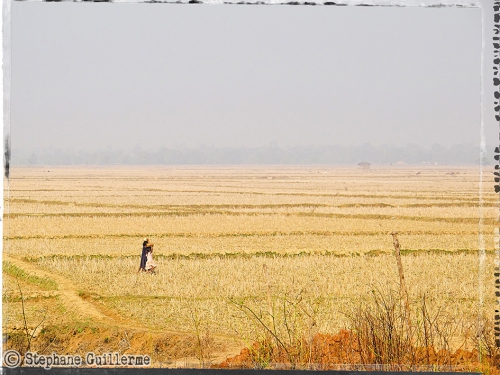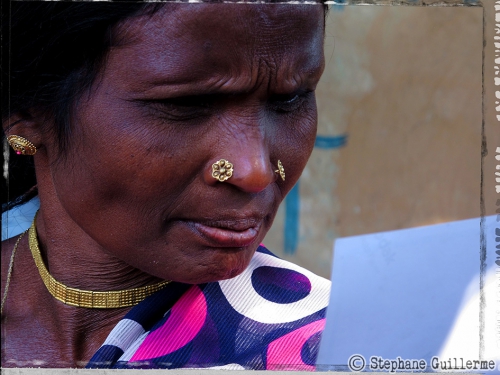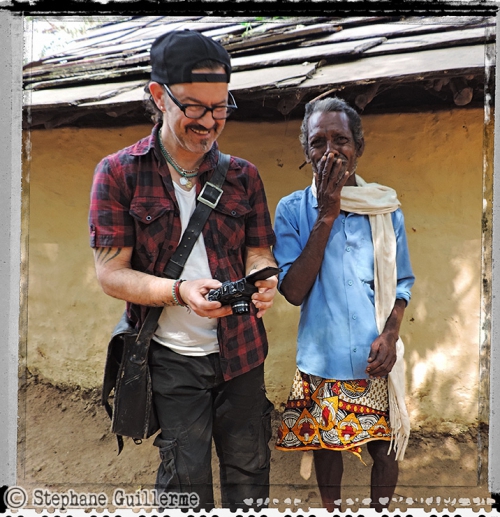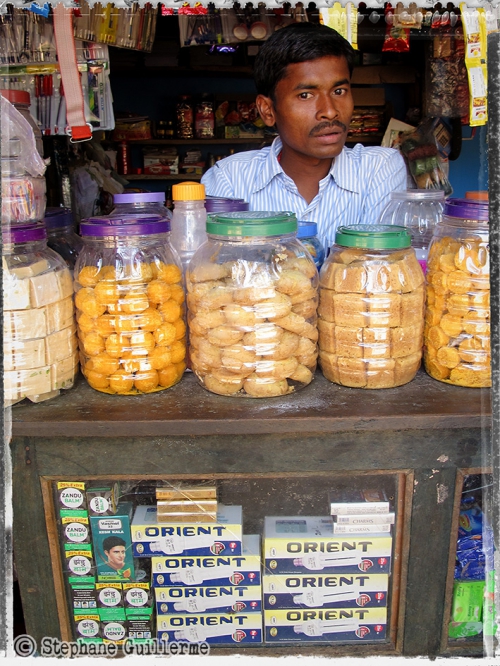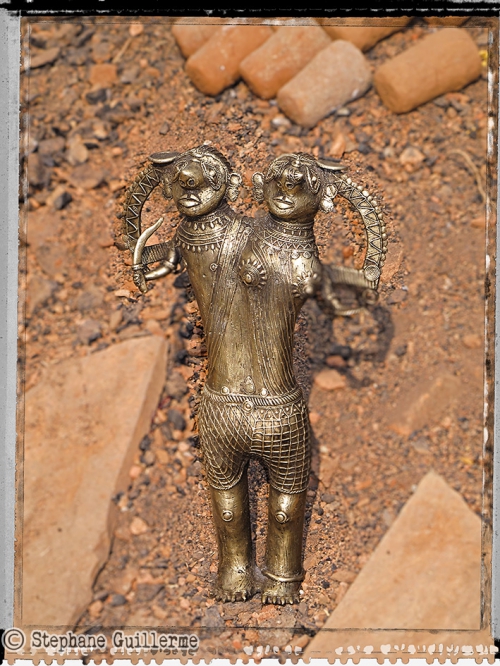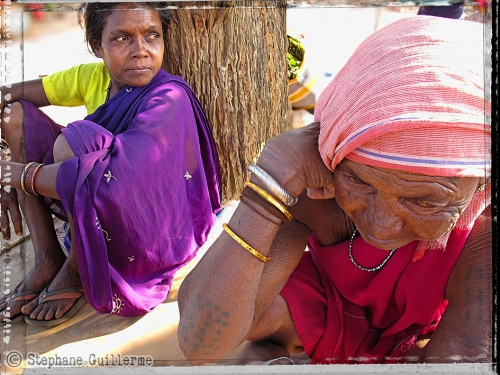19 Bastar
Un océan de champs de riz // An ocean of rice fields
Dans la nuit éclairée par la lune au plafond, la vaste étendue des champs de riz sans obstacle se transforme en mer imaginaire et les lumières des maisons de l'autre rive sont les signes de vie des cargos lointains. Je suis dans la région du Bastar, au sud du Chhattisgarh, fameuse pour ses cultures tribales et ses guérilleros naxalites, maoistes (ou simplement combattants d'un certain idéal de justice) que la puissante armée indienne met étrangement beaucoup de temps à déloger à l'heure où ce pays doté de satellites peut voir de l'espace de quelle couleur sont tes chaussettes. Et les médias semblent se plaire à ne parler du Chhattisgarh que pour évoquer la guérillera et ses coups d'éclats. Peut-être que l'Inde passe trop de temps à klaxonner et qu'un bruit en cache un autre, mais moi depuis un mois que je suis ici à sillonner l'état je n'ai rien entendu de suspect, ni vu de méchants guérilleros rugir dans les campagnes et dans la nuit. Allo allo papa tango ! Tout va bien, rien à déclarer !
Ce que je retiens de cet état jusqu'à maintenant ce serait plutôt de magnifiques perspectives sur des champs de riz entrecoupés de talus arborés à perte de vue, une population souvent curieuse et sympathique (l'étranger est une rareté et une étrangeté), de magnifiques campagnes égayées de villages si propres et encore souvent constitués uniquement de maisons construites en matériaux naturels et traditionnels, et cette impression d'être le premier « pardesi » (pas du pays) à découvrir l'endroit. En contre-partie je me souviendrai avec effroi de leur système de transport assez piteux qui transforme chaque déplacement en chemin de croix, une proposition d'hébergement restreinte et souvent plus chère qu'ailleurs (ce qui n'est pas un problème pour tout le monde), et des chiens en piteux état dans un grand nombre de villes et de gros villages traversés.
Chaque pièce a deux faces, voici celles du Chhattisgarh dont je me souviendrai, un état qui demande à être découvert et que revisiterai probablement prochainement, entre autre car le tatouage est aussi important que le nombre de groupes sociaux et ethniques que l'on croise dans le « bol de riz » (voir précédent sujet : Balod - Chhattisgarh).
Après le centre et le centre-est du Chhattisgarh, je me suis dirigé dans la région la plus « visitée » de cet état, la région de l'extrême sud, le Bastar, réputé pour ses cultures tribales constituées principalement de Dhurvaas, de Bhatras, de Sundis, de Maharas, de Panaras et d'hindous aussi. Cet incroyable enchevêtrement de groupes socio-ethniques cohabitent dans une région de plaines et de monts mais les cultures s'aplanissent au fur et à mesure de l'inéluctable avancée du « progrès » : école et télévision, de quoi bien formater les esprits.
Il reste néanmoins de quoi se réjouir de la rencontre de ces peuples généralement accueillant et souriant qui habitent des endroits naturellement beaux et encore plutôt sains.
Voici quelques clichés des environs de Nangur, au sud de Jagdalpur, une région à sillonner à moto et ça tombe bien : c'est comme ça que ça s'est fait :)
L'excellent Shakeel Rizvi interrogeant des femmes Mahara sur leurs tatouages.
The excellent Shakeel Rizvi is interviewing Mahara women on her tattoos.
In the bright night enlighted by the moon on the ceiling, the vast surface of rice fields turns into an imaginary sea and the lights from the other side of that rice land are the life signs of the distant cargos far offshore. I am staying now in the southern district of Chhattisgarh named Bastar, famous for its tribal cultures and its naxalites guerilleros, maoists (or simply fighters for an ideal of justice) that the indian army takes strangely a long time to get rid off at a time when satellites can tell in a second which colours are your socks. And the medias seem to have a tendency to talk about here only when naxalites strike somewhere (not that often in fact).
Maybe India spends too much time blowing its horns and that one noise covers other ones, but for one month that I tour the state, so far I have not heard nothing suspect neither seen dangerous warriors in the countryside by day nor by night.
Allo allo papa tango ! Here everything is fine, nothing to fear !
What I remember of the place until now would rather be the wonderful perspectives on rice fields, a welcoming and friendly population (foreigners are a local rarety), some beautiful landscapes with clean remote villages scattered here and there still built with natural and traditional materials, and this impressure to be the first « pardesi » (not from here, foreigner) to come around.
On the other hand I will remember with terror their transportation system that changes any trip into Stations of the cross, a rather small and poor choice of expensive accomodation (expensive for what you get), and starving dreadful dogs in the towns and villages that I crossed.
Every coins has two sides, here are the ones I will remember, a state that deserves the discovery and that I will visit again soon, especially 'cause the tattoos are as important as the number of socio-ethnic groups that you can meet in the « bowl of rice » (See the previous topic : Balod – Chhattisgarh).
After visiting some of the center and center-east of the state, I took the direction of the southern and most visited part of Chhattisgarh, the Bastar region, reknown for its tribal cultures, mainly the Dhurvaas, the Bhatras, the Sundis, the Maharas, the Panaras. This amazing entanglement of socio-ethnic groups live together in a region of plains and hills but many aspects of the local cultures are slowly being flattened by the « progress » : schools and television, just what it needs for a proper brainwashing.
Nevertheless there is still enough to enjoy this beautiful area of India that shelters a lot of friendly people in a rather clean environment.
Here are a few pics from the surroundings of Nangur, south of Jagdalpur, a region to discover by bike and, lucky me, that's the way I did it :)
Femme Ghadwa et son bébé // Ghadwa lady and her son
Femme Ghadwa, ses tatouages et sa cuisine // Ghadwa lady, her tattoos and her kitchen
Bhatra Buchia lady
La télévision est venue m'interroger dans une maison de Buchia Bhatra. Shakeel répond aussi aux questions et mon livre "God is pop" continue sa percée internationale
The television came to interview me in a Bhatra Buchia house. Shakeel Rivzi answers also a few questions and my book "God is pop" is still continuing his international life
Le vendredi c'est marché à Nangur et de nombreuses adivasis marchent des heures pour y aller, vendre et acheter
On friday it is market day in Nangur and many adivasis walk quite a long way to sell and buy
Marché de Nangur // Nangur market
Le Chhattisgarh est doté de très nombreux bassins artificiels d'eau où l'on se lave ou bien où l'on y cultive du poisson
Chhattisgarh is full of artificial water ponds where the people wash or where they grow fish.
Femmes Lohar au marché de Nangur // Lohar ladies on Nangur market
Femme Bhatra au marché de Nangur // Bhatra lady during Nangur market
Hommes Bhatra et leur troupeau // Bhatra men and their cattle
Femme Mahara et ses tatouages // Mahara lady and her tattoos
Femme mahara et ses bijoux // Mahara lady and her jewellery
Hommes Maharas. Celui du centre me montre ses tatouages : le serpent (naga) sur le biceps et un Aum sur la main
A Mahara man shows me his tattoos : a snake (naga) on the arm and a Aum on the hand
Hommes maharas // Mahara men
Adivasi converti au christianisme. Il porte un médaillon de Jésus
Adivasi who convert to christinity. He carries a necklace with the picture of Jesus
Et oui, faut bien travailler parfois !! Yes we all have to work sometimes !!
Moi avec un adivasi de la communauté Dhurvaa qui rit de se voir sur mon appareil photo
Me and an adivasi Dhurvaa who laughs to see himself on the camera screen
Ferme dans les bois de la communauté Dhurvaa // Farm in the forest belonging to a Dhurvaa family
Ferme dans les bois de la communauté Dhurvaa // Farm in the forest belonging to a Dhurvaa family
Un vieil homme au vieux cuir de la communauté adivasi Dhurvaa
An old man and his old leather from the Dhurvaa community.
Ferme isolée dans un hameau Dhurvaa // Isolated Dhurvaa farm
Un arbre et des champs de riz à perte de vue // A tree and an ocean of rice fields
Chez Suraj on refait le monde en s'enfilant des samosas, des pakoras et du chaï
At Suraj's place we discuss the world's affairs while eating samosas and pakoras and drinking chaï
Suraj s'est tatoué un S // Suraj tattooed an S
Epicier de village isolé du Chhattisgarh // Grocery store of an isolated village of Chhattisgarh
Un magicien est passé dans les environs // A magician just came around
L'art du Bastar // The art of Bastar
Homme Bhatra à droite et homme Ghadwa à gauche.
Celui de droite à une grosse boursoufflure sur son bras gauche provoquée par une fibre végétale que l'on attache au bras dans le cas de certaines maladies masculines très personnelles.
Bhatra man on left and Ghadwa man on right.
Autoportrait au pied du banyan, autoportrait pris par l'excellent guide du Bastar
Selfportrait of me shot by the excellent guide of Bastar-land of tribal, Mister Shakeel Rivzi
Hommes Ghadwa au pied d'un magnifique banyan // Ghadwa men below a giantic banyan
Femmes Panaras // Panaras ladies
Femme tribale Bhatra, son buffalo et ses tatouages // Adivasi Bhatra women, her buffalo and her tattoos
Tirthgardh Falls mela. Les pèlerins sont descendus de quelques marches pour aller se baigner dans les eaux des chutes de Tirthgardh
Pilgrims went a few steps down to bath in the waters of Tirthgardh Falls

Tatoueur de rue lors de la fête religieuse aux chutes de Tirthgardh // Street tattooist during the Tirthgardhmela

Tatoueur de rue lors de la fête religieuse aux chutes de Tirthgardh // Street tattooist during the Tirthgardhmela
Shiva de mela // Shiva mela style
Inscrivez-vous au blog
Soyez prévenu par email des prochaines mises à jour
Rejoignez les 90 autres membres

